Parkinson’s disease, a prevalent neurological disorder, has remained notoriously difficult to diagnose early, challenging timely intervention and treatment crucial for managing the disease effectively. However, an innovative advancement from researchers at the Hebrew University of Jerusalem promises to transform early detection methods. This groundbreaking discovery, a novel blood test, aims to identify Parkinson’s before symptoms appear, offering hope for millions affected by the disease. Characterized by a loss of nerve cells in the brain that reduces dopamine levels, Parkinson’s leads to impaired muscle control. Traditional tests have only detected the condition after significant neuronal loss, emphasizing the need for innovative solutions.
Understanding the New Blood Test
Mechanisms and Methodology
The pioneering blood test hinges on measuring a critical ratio of specific RNA molecules in the blood. Parkinson’s patients exhibit an accumulation of transfer RNA fragments (tRFs) linked to a decrease in mitochondrial RNA as the disease advances. This novel approach, documented in Nature Aging, calculates the ratio between these markers. The objective is to provide a reliable and accurate method for diagnosing Parkinson’s at an earlier stage. The importance of this development lies in its capacity to herald early interventions, potentially altering the treatment landscape altogether. By catching the disease early, medical professionals can implement strategies to slow its progression, sparing patients from severe deterioration.
Professor Hermona Soreq, who steered the research, emphasized the minimally invasive nature of this test. This quality assures a significant enhancement in early diagnostic capabilities for Parkinson’s, making it patient-friendly compared to existing options. The introduction of such a diagnostic tool could revolutionize current practices, shifting the focus from managing existing conditions to preventing severe damage by targeting the illness at its nascent stage. By doing so, this blood test sets the stage for a new era in Parkinson’s treatment, aiming to improve the long-term quality of life for patients.
Expert Perspectives
The promising possibilities of this discovery have not gone unnoticed in the scientific community. Professor David Dexter from Parkinson’s UK regards this development as a pivotal step toward establishing a biological marker for Parkinson’s. He envisions a future where the test facilitates accessible and widespread diagnostics, bringing preemptive measures to the forefront of treatment strategies. This shift aligns with a broader trend in medical science that prioritizes early detection and intervention. Such advancements are essential for efficiently managing various diseases, potentially improving outcomes dramatically.
Experts argue that early diagnosis facilitates personalized therapeutic approaches tailored to each patient’s needs. As a result, the medical community anticipates a proactive stance in combating neurodegenerative diseases. The blood test’s development not only specifically targets Parkinson’s but serves as a model, potentially adaptable for diagnosing other conditions. By spearheading the effort to implement a reliable and simple diagnostic method, researchers aim to lay the groundwork for similar innovations across the healthcare sector.
The Broader Implications of Early Detection
Shifts in Medical Practices
The technological progression represented by this blood test exemplifies a broader trend toward non-invasive and accessible tools aimed at early disease management. Such shifts herald a significant change in how medical professionals envision and execute treatment plans. With early detection capabilities, the medical community may adjust strategies to focus on preemptive therapies that alleviate symptoms and prevent further complications. This forward-thinking approach could redefine standard practices, ensuring patients receive timely attention that impacts long-term health positively.
The emphasis on accessibility and prevention rather than reaction signifies an impending transformation in the healthcare industry. By integrating non-invasive methods into standard practices, clinicians can extend diagnostic services to broader populations, eliminating barriers many patients face. These technological advances represent an ongoing commitment to developing patient-friendly solutions while maintaining accuracy and reliability. This evolution aims to unravel the complexities of neurodegenerative diseases, introducing tools any practitioner can utilize.
Future Directions and Challenges
Researchers at the Hebrew University of Jerusalem have made a remarkable breakthrough that could revolutionize early diagnosis methods for Parkinson’s. They have developed an innovative blood test designed to detect the disease before any symptoms manifest, offering renewed hope to millions of people affected by Parkinson’s. The disease is marked by the death of nerve cells in the brain, leading to decreased dopamine levels and impaired muscle function. Traditionally, diagnostic tests have only been able to identify Parkinson’s after considerable neuronal damage had occurred, underscoring the urgent need for new diagnostic solutions. This new test represents a significant step forward, potentially improving the lives of those who could benefit from earlier intervention and better management strategies.









